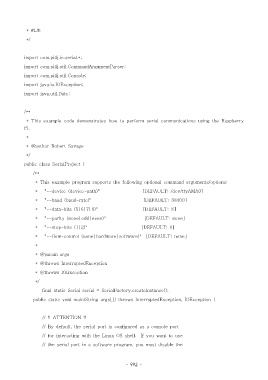Page 992 - 3-2
P. 992
* #L%
*/
import com.pi4j.io.serial.*;
import com.pi4j.util.CommandArgumentParser;
import com.pi4j.util.Console;
import java.io.IOException;
import java.util.Date;
/**
* This example code demonstrates how to perform serial communications using the Raspberry
Pi.
*
* @author Robert Savage
*/
public class SerialProject {
/**
* This example program supports the following optional command arguments/options:
* "--device (device-path)" [DEFAULT: /dev/ttyAMA0]
* "--baud (baud-rate)" [DEFAULT: 38400]
* "--data-bits (5|6|7|8)" [DEFAULT: 8]
* "--parity (none|odd|even)" [DEFAULT: none]
* "--stop-bits (1|2)" [DEFAULT: 1]
* "--flow-control (none|hardware|software)" [DEFAULT: none]
*
* @param args
* @throws InterruptedException
* @throws IOException
*/
final static Serial serial = SerialFactory.createInstance();
public static void main(String args[]) throws InterruptedException, IOException {
// !! ATTENTION !!
// By default, the serial port is configured as a console port
// for interacting with the Linux OS shell. If you want to use
// the serial port in a software program, you must disable the
- 992 -

